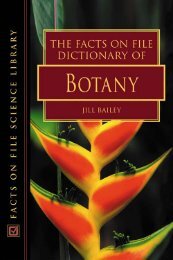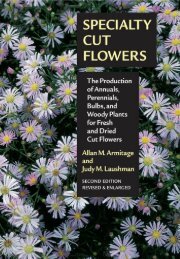Create successful ePaper yourself
Turn your PDF publications into a flip-book with our unique Google optimized e-Paper software.
3.66 3.6/<br />
3.68<br />
3.66 TS of the wood of the primitive dicotyledon Orimys<br />
winteri. This does not contain vessels and the tracheids (1)<br />
are of rather uniform diameter. Both uniseriate (2) and<br />
multiseriate rays (3) are present. (LM x 90.)<br />
1 Tracheids<br />
2 Uniseriate ray<br />
3 Multiseriate ray<br />
3.68 TS of the diffuse porous wood of the dicotyledon<br />
Magnolia grandif/ora. The small and fairly uniform vessels<br />
occur evenly throughout the growth ring except for a<br />
narrow band of late wood (1). Numerous, narrow<br />
multiseriate rays are presenr (2). (LM x 25.)<br />
t Late wood vessels<br />
2 Multiseriate rays<br />
3.69 Trunk of a large specimen of Cedrus deodora<br />
(cedar) showing the scar of a large side branch. In<br />
gymnosperms (in contrast to most angiosperms, cf., 3.37)<br />
the reaction (compression) wood, forming the thicker part<br />
of the eccentric xylem, lies on the underside of the branch<br />
(I, indiC:lIes the position originally occupied by the pith).<br />
Note the callusing at the margins of the sca'r which is<br />
beginning to cover the wound with (;Ork (2)<br />
3.67 TS of the ring porous wood of the dicotyledon<br />
Quercus alba (oak). The largc-diametered early-wood<br />
vessels (1) contrast with the smaller-diametered vessels of<br />
the late wood. The latter are distributed in more·or-Iess<br />
radial bands of vessels (2) alternating with areas of very<br />
narrow tracheary elements. Numerous rays are also<br />
evident. (LM x 25.)<br />
1 Early-wood vessels<br />
2 Late wood vessels<br />
I Onginal position of pith<br />
2 Wound cork<br />
83<br />
3.65





